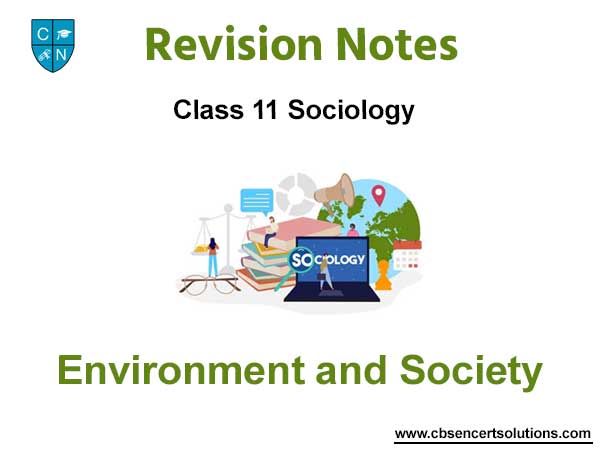Please refer to Environment and Society Class 11 Sociology notes and questions with solutions below. These revision notes and important examination questions have been prepared based on the latest Sociology books for Class 11. You can go through the questions and solutions below which will help you to get better marks in your examinations.
Class 11 Sociology Environment and Society Notes and Questions
Every society has an ecological basis. Mountains, rivers, Plains, oceans, flaura and fauna – all depends on ecology.
Social environments
Social environments come from the interaction between bio physical ecology and human interactions. This is a two way process. Nature shapes society and society shapes Nature.
Social organisations
The interaction between the environment and society is shaped by social organisations. Property relations determine how and by whom natural resources can be used.
Eg: The government had the power to decide what to do with the forest owned by it.
Social values and norms
Social values and norms also show the relationship between environment and society. The capitalist values supported the commodification of nature. The socialist values stands for justice and equality. The religious values encourage protection and conservation of sacred groves.
Risk societies
Environmental management is very difficult. Human relations with the environment have become increasingly complex. Ecosystems are adversely affected by resources extraction for different industries. We are live in risk societies.
Eg: The disasters that occurred at Chernobyl, industrial accidents like Bhopal, Mad cow disease in Europe.
Major environmental problems and risks
Environmental problems that world faces today are different for different countries both in nature and intensity. The most dangerous problems are given below.
1) Resource depletion
Two types of resources
1. Renewable energy source – which can supply continuously
Eg: hydro power, bio gas, solar, wind energy
2. Non-Renewable resources – energy source which will be exhausted
Eg: coal, petroleum products
The excessive use of non renewable natural resources is one of the most serious environmental problems.
Eg: the depletion of water, top soil, bio diversity habitats etc.
2) pollution
There are three types of pollutions
1. Air pollution
Air pollution is one of the most dangerous environmental pollution in almost all the industrialised and it urbanized cities and towns.
Sources:
a. Natural sources
Volcanic eruptions, forest fires, dust storms
b. Man-made causes
Industrial emissions, automobile emissions
Air pollution seriously and adversely affects human health. Some diseases caused by polluted air.
2. Water pollution
Water is said to be polluted when it’s quality of compositions is changed directly or indirectly as a result of human activities.
Sources:
Sewage and other wastes
Domestic wastes
Industrial wastes from chemical factories
Agricultural discharges
Wastes from fossil fuel plants and thermal power plants
3. Sound pollution
Unwanted sound which produce undesirable physiological and psychological effect.
Sources:
Means of transportation
Industrial operations
Construction activities
Celebrations
Sound pollution also creates several health problems.
3) Global warming
Global warming means a gradual increase in the overall temperature of the Earth’s atmosphere generally contributed to the green house effect caused by the increased level of carbon dioxide,chloroFluro Carbons and other pollutants. Global warming affects the ecological balance. It creates uncertainties and fluctuations in climates. The entire ecosystem would experience change.
4) Genetically modified organisms
Genetic modification is the process by which scientists splice genes of one species and introduce it into another there by producing new characteristics. Genetic modification may also be done to shorten growing time, increase size and the shell-life of crops.
Genetically modified organisms, negatively affect human health. This could result from differences in nutritional content, allergic response or undesired side effects.
5) Natural disasters and man-made environmental disasters
Natural disasters – earthquakes, flood and fires, volcanoes, Tsunami, etc..
Man-made disasters – war, pollution, nuclear explosion, etc..
Both natural and man-made disasters create several problems in our environment.
Environmental problems are also social problems
Environmental problems are simultaneously social problems, as the way they affect different social groups is associated with social inequality. In today’s global society, many environmental issues can diminish the quality of life on earth including over production of waste, the destruction of natural habitats and the pollution problems. Some environmental problems are universal, such environmental problems will create public interest but the sociological analysis shows the attempts to protect the public interest are not useful to all. The activities in the name of protecting the public interest actually serve the interest of politically and economically powerful groups, they hurt the interest of the poor and politically weak.
Eg : construction of dams or commercial exploitation of forest for timber
Social ecology
The Concept of social ecology was introduced by an environmental activist named Murray Bookchin. Social ecology is the study of how individuals interact with and respond to the environment around them, and how these interactions affect Society and the environment as a whole.



